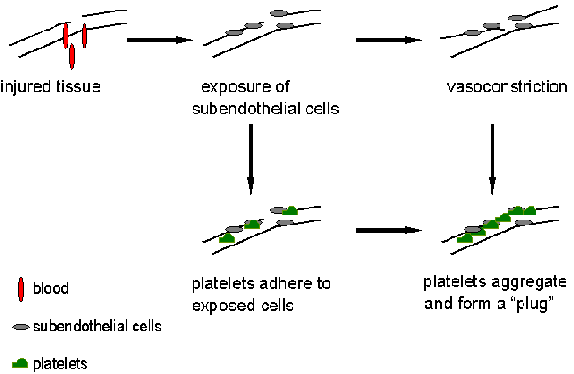Anticoagulants
Compounds that do not allow blood to clot
are called anticoagulants. These include drugs such as heparin and coumarin.
Drugs that dissolve pre-formed clot including streptokinase are not
referred to as anticoagulants.
Anticoagulants are usually administered to
patients with myocardial infarction, venous thrombosis, peripheral arterial
emboli and pulmonary emboli. They have been used to prevent transient ischemic
attacks and to reduce the risk of recurrent myocardial infarction.
The circulatory system has to be
self-sealing, otherwise continued blood loss from even the smallest injury would
be life threatening. Normally, all but the most catastrophic bleeding is rapidly
stopped, a process known as hemostasis. This process occurs through a
progression of several steps.
Hemostasis is a combination of events
that occur due to physical and chemical forces. The initial steps lead to a
reduction in the blood flow due to the formation of a cellular plug. The later
steps utilize chemical energy to form a blood clot, medically known as
thrombus.
The Physical Process

The aggregating platelets and the damaged
tissue initiate the biochemical process of blood clotting or coagulation, the
body's major defense against blood loss.
A blood clot forms as a result of concerted
action of some 20 different substances, most of which are plasma glycoproteins
(Table).
|
Coagulation
Factors |
|
Factor |
Name |
Plasma half-life (h) |
| |
|
|
| I |
Fibrinogen |
72
- 96 |
| II |
Prothrombin |
60 |
| III |
Tissue Factor or thromboplastin |
-- |
| IV |
Ca++ |
-- |
| V |
Proaccelerin |
15 |
| VII |
Proconvertin |
5 |
|
VIII |
Antihemophilic A factor |
10 |
| IX |
Antihemophilic B factor or Christmas factor |
25 |
| X |
Stuart or Stuart-Prower factor |
40 |
| XI |
Plasma thomboplastin antecedent |
45-65 |
| XII |
Hageman factor, contact factor |
60 |
|
XIII |
Fibrin stabilizing factor |
150 |
| |
Prekallikrein factor |
-- |
| |
High-molecular-weight kininogen |
156 |
The phenomenon of blood coagulation is
traditionally distinguished into two pathways. These pathways are the
intrinsic and the extrinsic
pathways (Figure below). The intrinsic pathway is defined as a cascade that
utilizes only factors that are soluble in the plasma, whereas the extrinsic
pathway consists of some factors that are insoluble in the plasma, e.g.,
membrane-bound factors (factor VII). However, the boundary differentiating these
two is becoming more and more blurred.
|